Last Nasdaq analysis expected upwards movement to end at resistance at the bear market trend line. Price has turned short of the line.
Summary: Nasdaq has had a trend change. The target for a third wave down is 3,227. It may be met in about another ten weeks.
New updates to this analysis are in bold.
BEAR WAVE COUNT
MONTHLY CHART
Grand Super Cycle wave II may be an incomplete flat, combination or double flat.
A new low below 2,861.51 would invalidate the bull wave count and confirm a huge market crash.
All subdivisions are seen in exactly the same way, only the degree of labelling is different.
If Grand Super Cycle wave II is a combination, then super cycle wave (y) would be a zigzag or triangle.
If Grand Super Cycle wave II is a double flat, then super cycle wave (y) would be a flat correction ending about the same level as super cycle wave (w) at 1,160.
If Grand Super Cycle wave II is a regular flat, then super cycle wave (c) would be a five wave structure to end below super cycle wave (a) at 1,160 to avoid a truncation.
WEEKLY CHART
The degree of labelling within downwards movement from the all time high only has been moved up one degree this week.
Downwards movement from the all time high may be a first wave for primary wave 1, a deep second wave correction for primary wave 2, and now an incomplete third wave for primary wave 3.
Primary wave 1 may have ended with a truncation. This is possible after the prior move of minor wave 3 moved “too far too fast”.
Primary wave 3 must move far enough below the price extreme of primary wave 1 to allow for room for the following correction of primary wave 4 to unfold and not move back into primary wave 1 price territory.
So far within primary wave 3 intermediates (1) and (2) are complete. A third wave at two large degrees may be just beginning.
The prior bull market trend line was breached by a close (on a daily basis) by more than 3% of market value on 24th August 2015. This indicated the market had changed from bull to bear. The same technique will be used again, in the opposite direction.
A bear market trend line is drawn from the all time high to the first major swing high within the bear market labelled intermediate wave (2). The bear market should be expected to remain intact while price remains below this trend line. When this trend line is breached by a close (on a daily basis) of 3% or more of market value, then it would be indicating a trend change from bear to bull.
DAILY CHART
The channel about intermediate wave (2) has been clearly breached by downwards movement. Price fell short of the bear market trend line.
Minor wave 1 may be incomplete. When it is done, a bounce for minor wave 2 may last a few days and would still most likely correct to the 0.618 Fibonacci ratio of minor wave 1. The small cyan trend channel is a best fit about this downwards movement. When it is clearly breached by upwards movement, then minor wave 2 would most likely have started.
Minor wave 2 may not move beyond the start of minor wave 1 above 4,969.32.
BULL WAVE COUNT
MONTHLY CHART
Grand Super Cycle wave II is seen here as over in just 31 months. This is possible, but it is more likely it would last longer than this.
This wave count sees Nasdaq in a Grand Super Cycle wave III upwards.
There is no Fibonacci ratio between cycle waves I and III.
Super Cycle wave (I) is an incomplete impulse. Within Super Cycle wave (I), cycle wave IV may be complete.
Cycle wave II was a very deep 0.91 zigzag lasting 17 months. Cycle wave IV may have exhibited alternation as a shallow flat lasting just 7 months. This is possible, but what is equally as possible is cycle wave IV may continue sideways as a double flat or double combination. Only a clear five up on the daily chart would eliminate these possibilities. A trend change at cycle degree requires confirmation with a new high above 5,176.77 (to invalidate the bear count) and a five wave structure upwards on the daily chart.
Cycle wave IV may not move into cycle wave I price territory below 2,861.51.
WEEKLY CHART
Cycle wave IV is most likely to be a flat, combination or triangle to exhibit structural alternation with the zigzag of cycle wave II.
Regular flats fit well within trend channels. Their C waves normally are about even in length with their A waves. Primary wave C is just 35.97 points longer than equality in length with primary wave A.
The degree of labelling within cycle wave IV may be moved down one degree. This flat correction may be only primary wave A of a larger flat, or a triangle, or primary wave W of a double flat or double combination. A clear five wave structure upwards on the daily chart is absolutely required before any confidence may be had in this wave count.
Unfortunately, the upwards wave which has recently ended is not clear. It would subdivide both as a zigzag and an impulse. As it is impossible to determine with certainty which one it is, both possibilities must be considered. This wave count is still technically valid.
TECHNICAL ANALYSIS
MONTHLY CHART
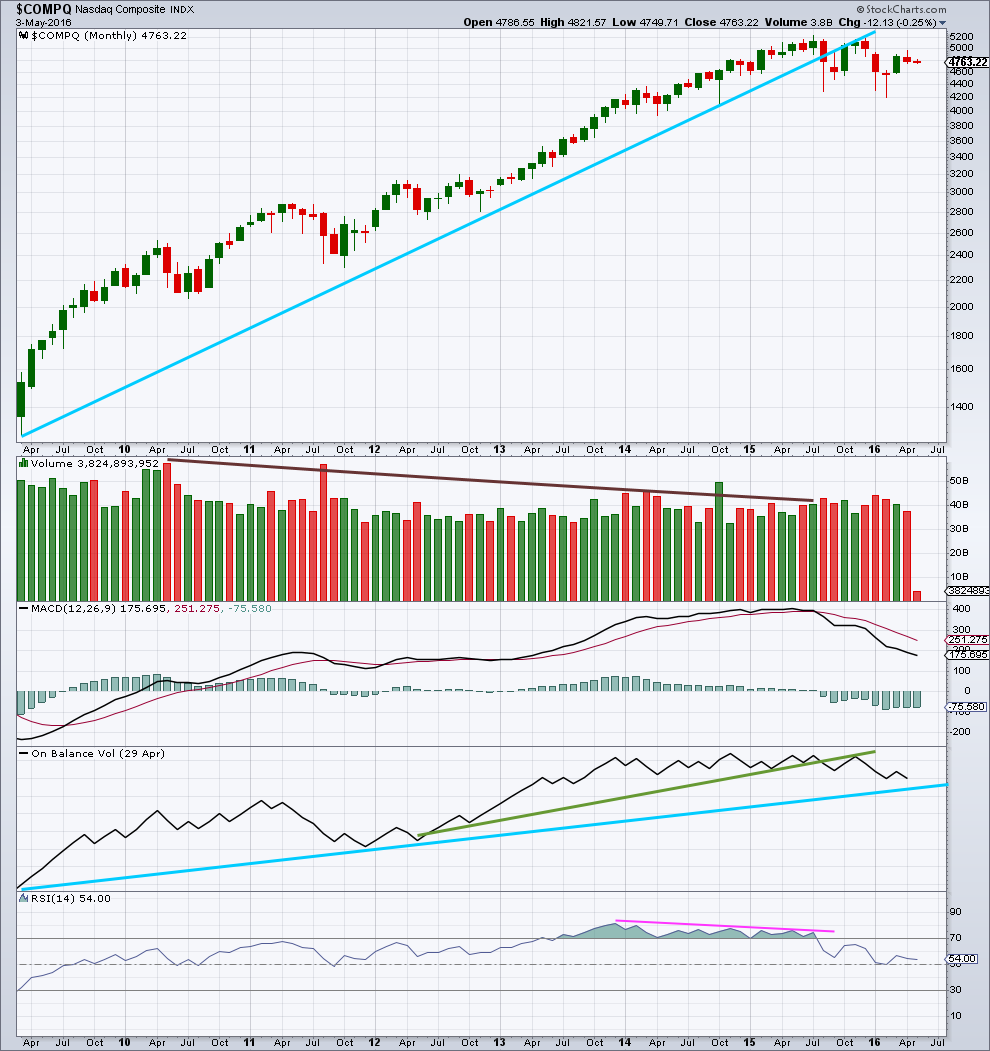
Click chart to enlarge. Chart courtesy of StockCharts.com.
A more conservatively drawn trend line from the end of March 2009 is drawn here (blue line). It was reasonably shallow, repeatedly tested, and is highly technically significant. It has been breached and provided resistance.
Since May 2010, overall, as price rose to all time highs volume declined. The bull market was not well supported by volume and is suspicious.
There was slight negative technical divergence with price and MACD at the all time high.
As price has fallen four out of five months from the all time high it comes with overall declining volume. The fall in price is not being supported by volume for Nasdaq. This is not necessarily suspicious as the market can fall of its own weight.
On Balance Volume has breached a trend line held since May 2012, (green line) which is bearish. OBV turned up and tested the green line which held. The strength of that line is reinforced. This is further bearish indication. The blue line is redrawn this week. OBV should find support at the blue line, which may initiate a bounce.
There is negative divergence between price and RSI going back to December 2013, as price made all time highs. This is a strong bearish indicator. This was also seen up to March 2000, and was followed by a 78% drop in market value to the low of 1,108 in October 2012. It does not mean that the market must make a similar fall at this time, but it is a strong bearish indicator.
DAILY CHART
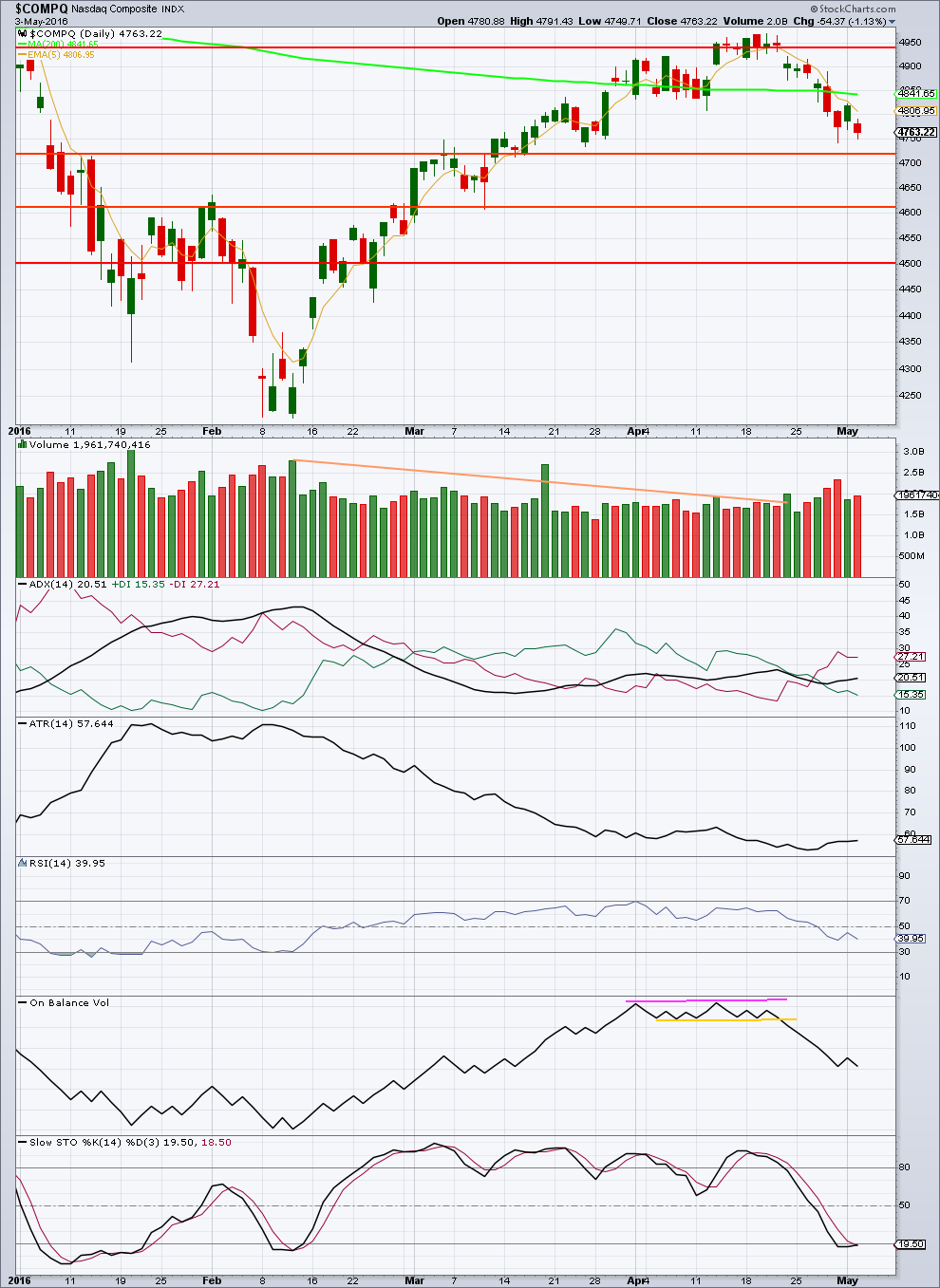
Click chart to enlarge. Chart courtesy of StockCharts.com.
Nasdaq is in a bear market until proven otherwise.
1. The 200 day moving average is flat to declining.
2. Price has breached a bull market trend line.
3. Price remains below a bear market trend line.
4. From the all time high, price has made a series of lower lows and lower highs.
5. Bear market rallies from the all time high have been very deep and fully retraced.
Even if one of these five conditions is broken, that would not alone be enough to confirm an end to the bear market and a new bull market. The one thing which would fully and finally confirm a new bull market would be a new all time high. Prior to that a balance of these conditions being broken would strongly indicate a new bull market.
It should always be assumed that the trend remains the same, until proven otherwise.
The bear market rally came with declining volume. The rise in price was not supported by volume and so was suspicious. Now price is falling on increasing volume. This supports a trend change and more downwards movement.
ADX indicates there is currently a new downwards trend. It is increasing and the +DX line is above the -DX line.
ATR is now beginning to increase after a long period of declining. ATR agrees with ADX; the market is trending downwards.
On Balance Volume is moving lower with price. There is no support line that has been found at the daily chart level for OBV.
RSI is not yet extreme. There is room for price to fall.
Stochastics is now entering oversold, but this oscillator may remain extreme for reasonable periods of time during a trending market. Its best use is for divergence to indicate trend weakness.
While I have found a Fibonacci 13 day moving average useful for support during recent upwards waves, a shorter Fibonacci 5 day moving average better shows support for the faster downwards waves. It may be useful here again.
This analysis is published @ 04:48 a.m. EST.

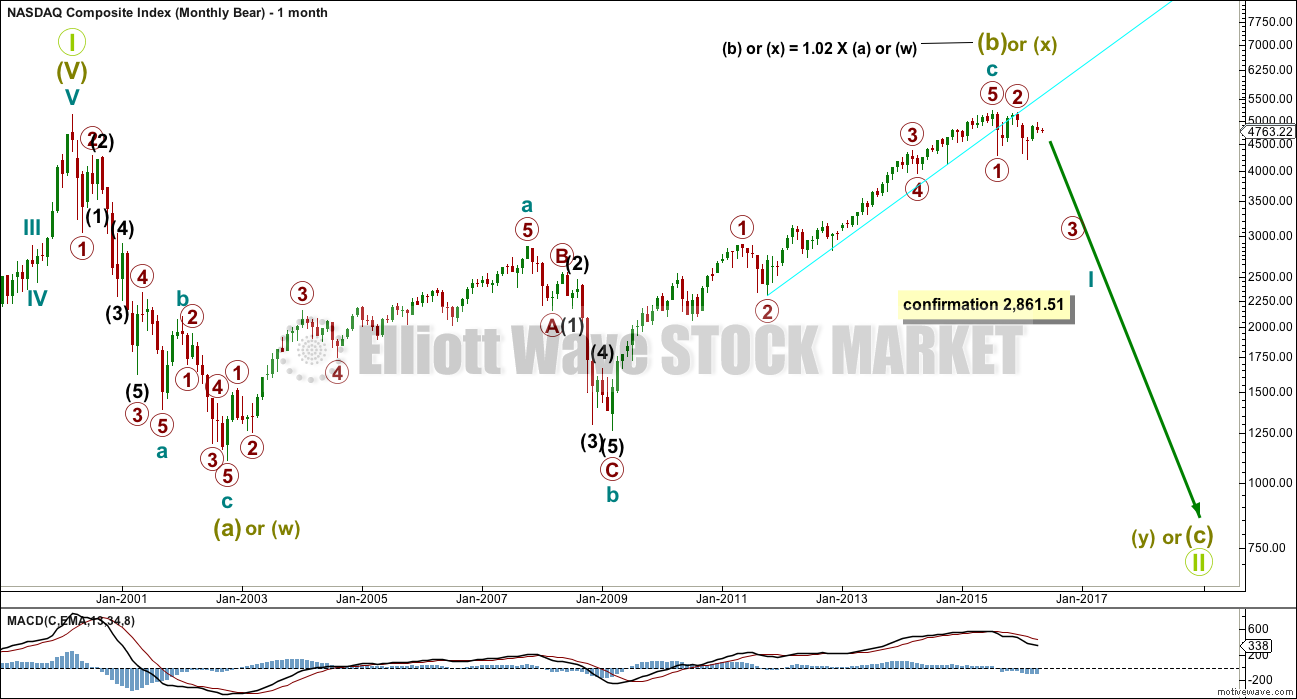
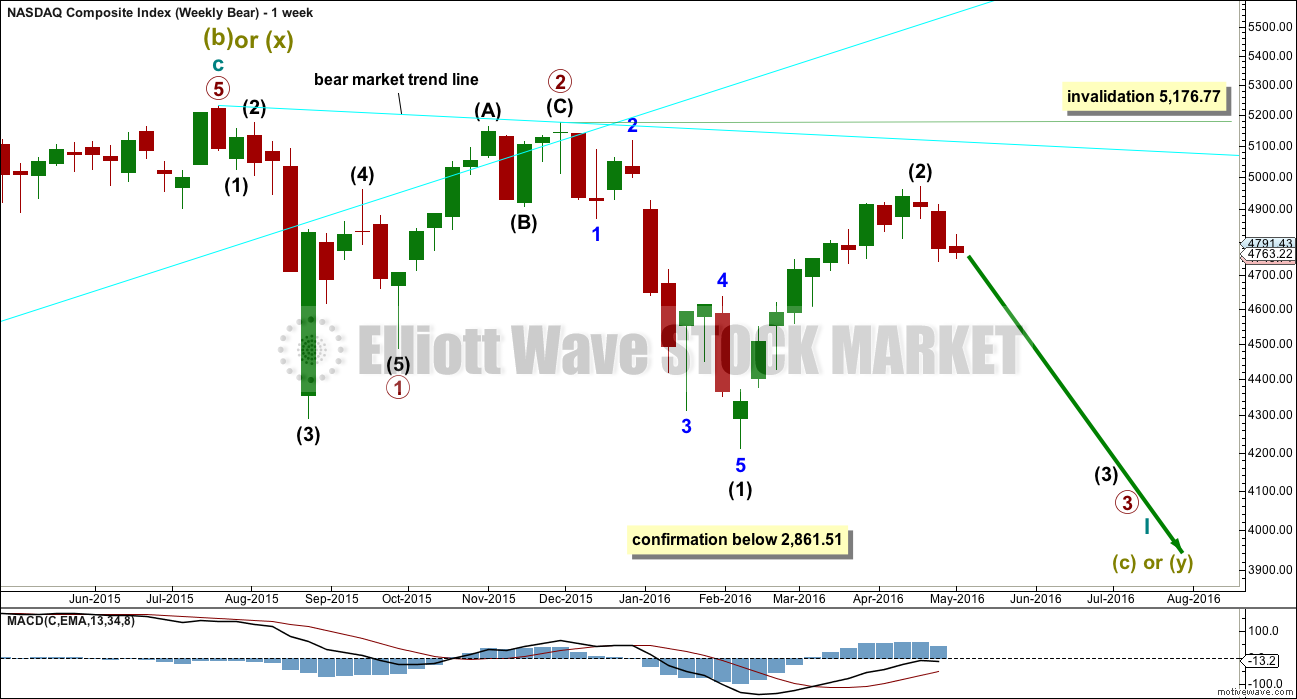
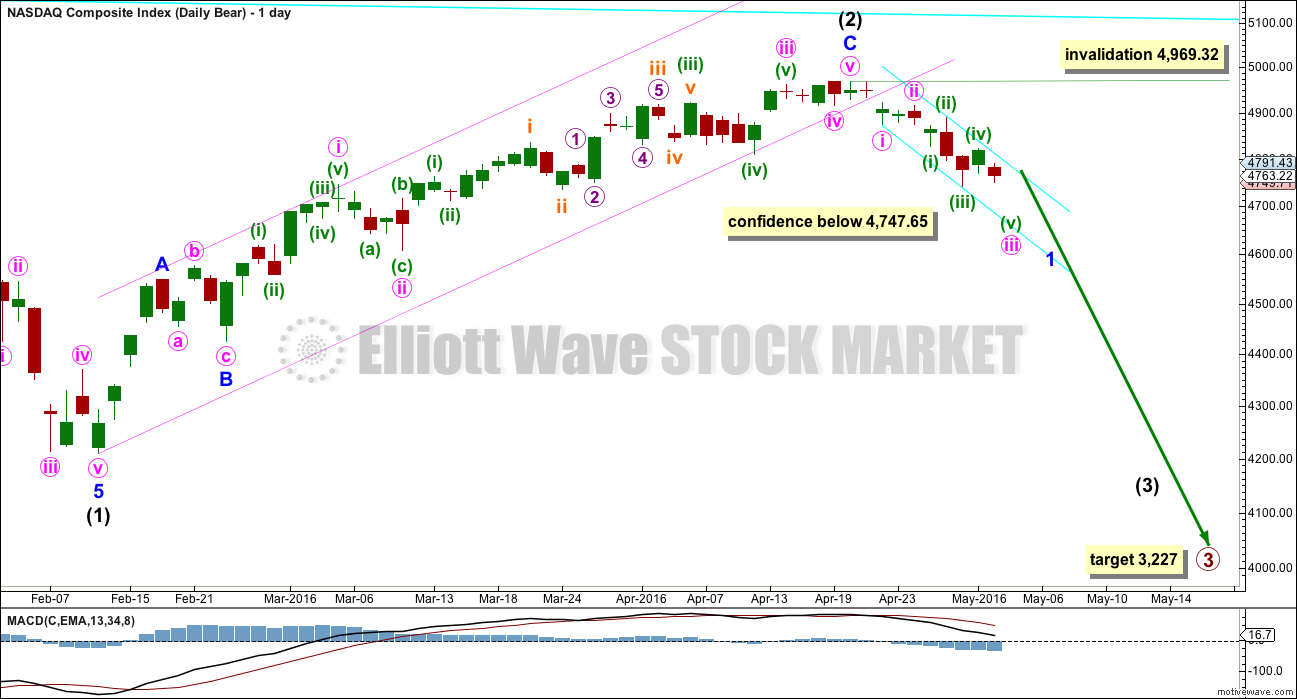
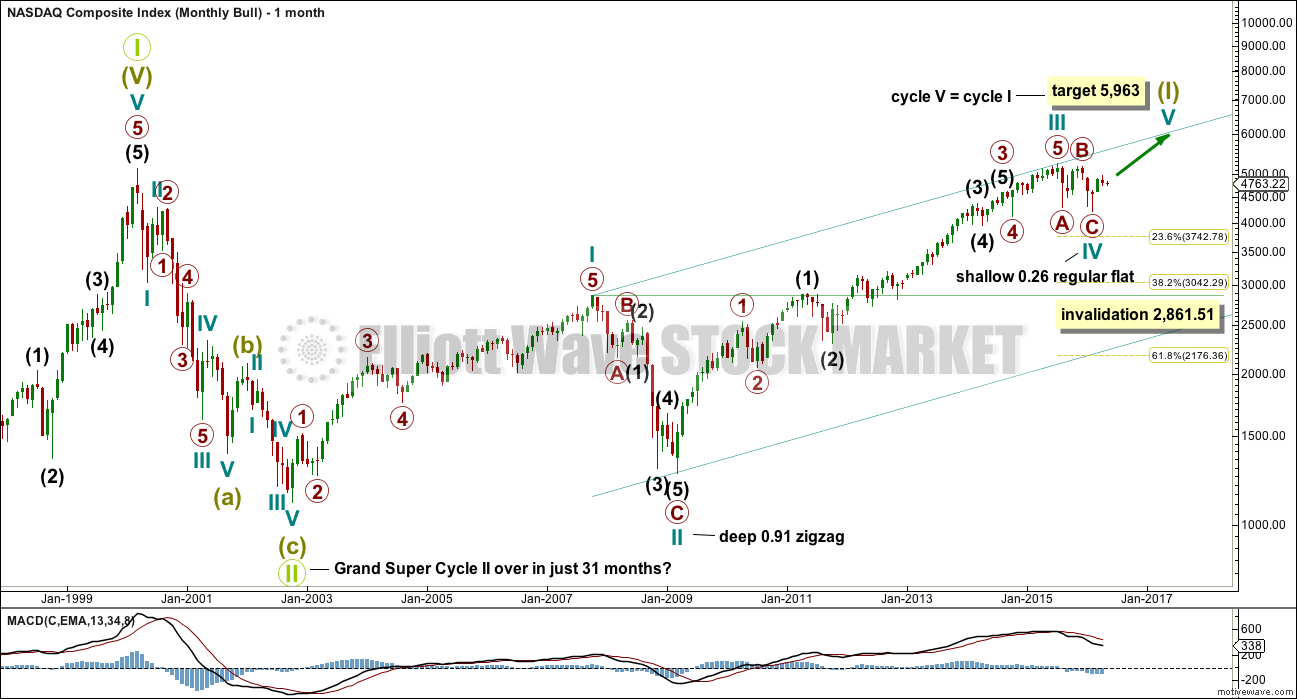
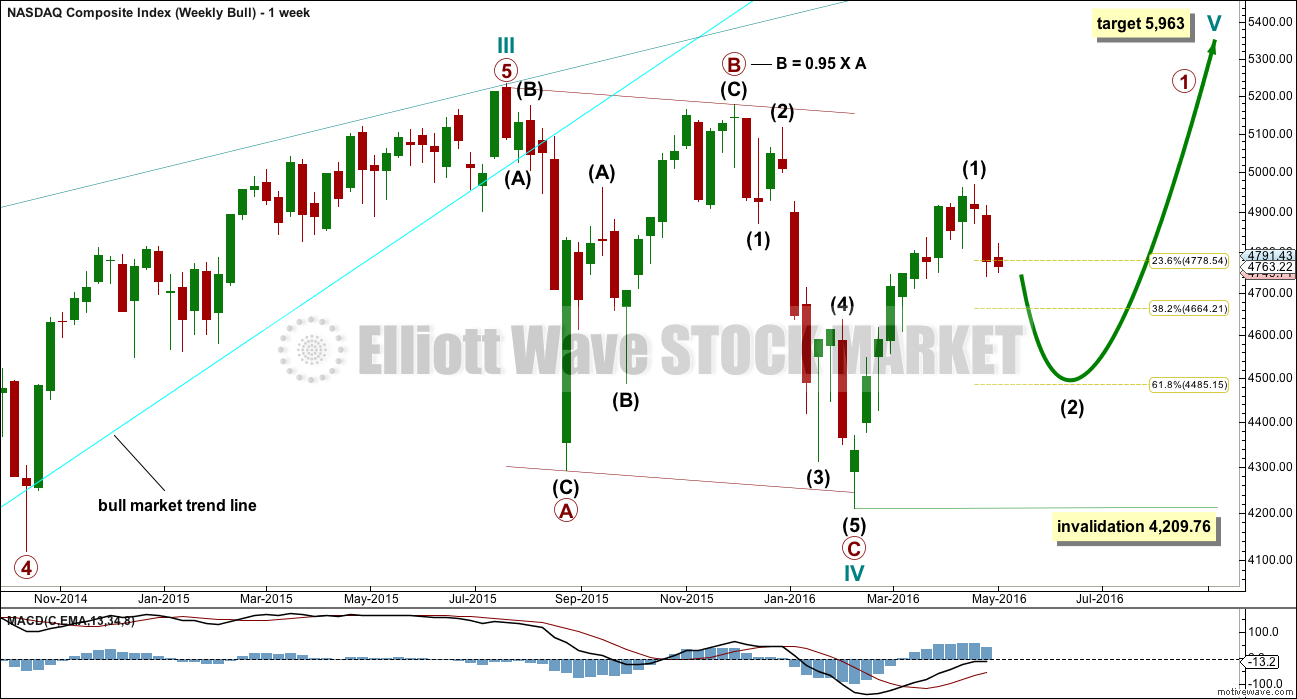
Lara,
It is really nice to have analysis of the NASDAQ to compliment your SPX analysis. It is great to have the confirmation point of 4747 to use in conjunction with the SPX 2039 confirmation point.
I just have one problem though. I told you I need to leave for some time in early July. Your projection to complete Intermediate 3 is 10 weeks. That is too long by a week or two. Please use your powers to hasten it a bit.
Thanks again. I am most appreciative. I must admit, your service is without a doubt the best available and the best value.
Yeah, really sorry about that Rodney. Mr Market is being a bit slow I think.
Perhaps we should get that bear to stop sneaking and peeking and give him a kick or two to hurry up?